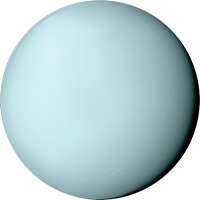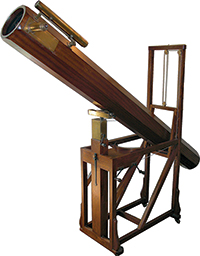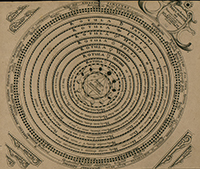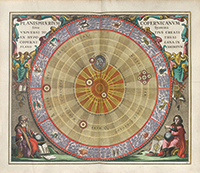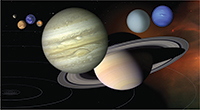
NASA
Uranus, the blue-green ball to the right, next to a blue Neptune—in this artist’s rendering of the solar system’s planets—became the seventh known planet in 1781. The smaller, dark-blue circle on the left is our home.

Wikimedia Commons
William Herschel, first thought his discovery—the planet Uranus, a star or a comet.
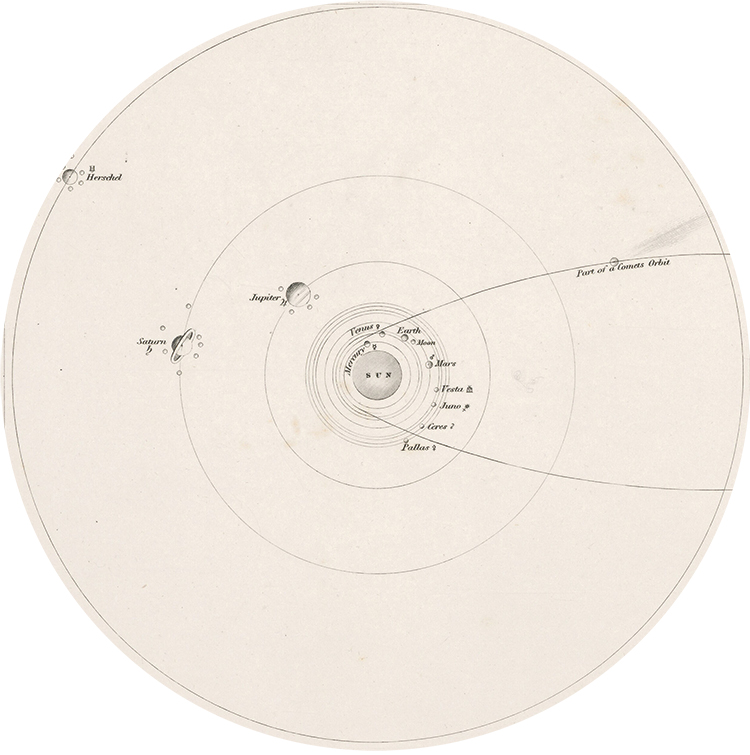
Beinecke Library, Yale University
A diagram of the solar system with Herschel’s “U(ranus)” skimming the circumference.

NASA
Carl Sagan called earth, in this photo from Voyager 1, a “fraction of a dot,” a bobbing speck in the oceans of the universe.
Expanding the Boundaries of Man's Understanding
by Ben Swenson
An amateur astronomer looked into his telescope March 13, 1781, and saw something that moved the boundaries of man's understanding of the cosmos. A fixed number of planets had always spun around the sun, but that day the solar system got bigger. He had discovered a world: Uranus.
By itself, spotting Uranus added a member to the known family of planets and propelled a musician-turned-astronomer to prominence. The broader significance was in the questions his find posed. If a planet had been hiding out there all along, what else was there to be found? Scientists peered into the sky and opened volumes of evidence suggesting the universe was not the finite and ordered bubble of ancient and conventional wisdom.
That expansion of information fostered a shift in perception about humanitiy's ever-shrinking place in the cosmos, signaling a new age of astronomy wherein the deeper people peered into the sky, the smaller they became.
All the planets beyond earth until then known—Mercury, Venus, Mars, Jupiter, Saturn—had been observed and named by the Greeks and Romans, who, by the way, considered the sun and the earth’s moon planets, too. William Herschel, a German-born Englishman, a professional musician, and an enthusiastic part-time scientist, had discovered from his Bath, England, home another satellite of the sun. A competent if avocational astronomer inclined to science and math, and a student of the stars, Herschel seemed at first not to consider that he had found a planet.
In April, after Herschel shared the news, Astronomer Royal Nevil Maskelyne wrote to him: “Sir, I am to acknowledge my obligation to you for the communication of your discovery of the present Comet, or planet. I don’t know what to call it.”
Herschel had written of Uranus’s first sighting: “In the quartile near Zeta Tauri the lowest of the two is a curious either nebulous star or perhaps a Comet.” Three weeks later he still referred to “the Comet,” which he said was “pretty well defined, no appearance of any beard or tail.” Doubts vaporized as it became clear the object was a planet—a speck of light, barely visible to the naked eye, which, unlike the stars around it, moved a little every night.
Herschel’s find got the attention of King George III, who bestowed on him the title of King’s Personal Astronomer, which came with an annual £200 pension. Herschel had named the newfound planet Georgium Sidus, or George’s Star, in honor of his sovereign and fellow Hanoverian German. With the king’s blessing, he moved closer to the royal residence at Windsor and gave up music to pursue astronomy full-time.
Making the move with Herschel was his sister, Caroline Herschel, who had been his assistant and helper through nights of stargazing. She, too, secured a royal stipend, £50.
Herschel, his sister at his side, found two moons of Uranus and two moons of Saturn and noted that Martian icecaps changed volume with the seasons. He discovered infrared radiation and concluded that the solar system is moving through space. During his career, Herschel found and recorded more than 800 binary stars and 2,500 nebulae, then a general category for faint patches of light in the night sky. His work introduced deep space to a populace that did not know what a vast and turbulent universe they inhabited.
For centuries, there had been steady progress in astronomy. The Scientific Revolution, which lasted from the sixteenth to the eighteenth century, established heliocentrism—the theory laid out by Copernicus and later by Galileo that the earth revolves around the sun—and such thinkers as Johannes Kepler and Isaac Newton developed new ideas about bodies in outer space.
Nevertheless, astronomy had always been, for the most part, a planetary science. Inquiry had focused on the sun, moon, planets, and comets. Distant stars were a backdrop—fixed beacons by which astronomers measured and recorded nearby, more active heavenly bodies. Solar system scholarship yielded ever-more accurate data on the planets, which described the solar system as neat, orderly, and reliable. Many saw divine design in the natural patterns.
“It must be a noble Entertainment, indeed, and something wonderfully engaging to the human Mind, to contemplate the glorious Theatre of Nature; where the Divine Geometrician, as Plato calls him, has observed exactest Rules of Symmetry and Proportion,” wrote an editorialist in the August 22, 1752, issue of London’s General Advertiser. “The regular Vicissitudes of the Seasons and the constant and invariable Returns of Day and Night; the Revolutions of the Planetary Orbs; and the Phaenomena of the Heavens must be beautiful Spectacles indeed.”
Educated laymen had at least a passing interest in astronomy, and learned men often more. Virginia’s George Wythe, legal scholar, founding father, and Williamsburg resident, cut a hole for a telescope in a window shutter of his Palace Green home. Newspapers reported celestial phenomena and discoveries. On October 22, 1772, for example, the Virginia Gazette told subscribers to look in the night sky for the “largest and most beautiful planet Jupiter. It will be seen to rise for several evenings (almost in the east) at nine o’clock, and sets about six in the morning.” The newspaper encouraged readers to view Jupiter through a telescope to take in the giant planet’s then-known four moons, which were to be “seen every night in different positions.”
Such bulletins often said that nighttime marvels were planned and produced. Jupiter’s arc across the sky, according to the notice, was the work of the “ALMIGHTY ARCHITECT,” the moons put there by “Providence, to counterbalance” the planet’s distance from the sun.
To the eighteenth-century public, the dynamic solar system and the static stars beyond made a wondrous spectacle, a finished, perfect creation that adhered to ages’ old, predictable formulae. Humans, who were able not only to witness but to appreciate that construction, were select beings. Nevertheless, chaos was as common as the order they saw in the vacuum of space and the night sky.
There was gathering speculation among scientists, as early as René Descartes in the mid-seventeenth-century, that deep space was larger than most had supposed. One of the astronomers Herschel most respected spoke of the universe’s scale. “It is not to be imagined that all the stars are placed in one concave surface, so as to be equally distant from us,” wrote James Ferguson in his 1756 work, Astronomy, Explained upon Sir Isaac Newton’s Principles. Instead, the stars “are placed at immense distances from one another through unlimited space.”
Herschel sought to build on these suppositions. He was corroborating the speculations of large-universe theorists by documenting binary stars and nebulae when Uranus came into focus.
In light of growing evidence that there was a lot to learn about the universe beyond Saturn, Uranus challenged the broad outlines of the cosmos as people understood it, consisting of the planets earlier observed and comets passing by now and then, with a twinkling fabric somewhere beyond.
Herschel had cast doubt on the universe as a finite, finished creation as early as 1774, when he noticed that the Orion nebula looked different than in an observation more than three decades before. His discovery of Uranus seven years later raised the possibility that our cosmic neighborhood held more secrets. Its addition to the solar system laid the groundwork for the discovery of Neptune in 1846 and Pluto in 1930, which lost its planetary status in 2006.Herschel’s subsequent findings built a foundation for other emerging scientific theories. The deep space Herschel described, for instance, corresponded with the deep time necessary for Charles Darwin’s idea of natural selection. The universe as Herschel revealed it was unknown, vast, and changing.
Such revelations upset people who perceived the cosmos as a completed masterpiece—an idea embedded in the highest scientific circles despite the overt religious trappings. The Church of England had influence over university professors and royal appointees, and conclusions that contradicted dogma did not sit well with religious and secular authorities.
Uranus’s discovery disturbed the solace found in the recurring patterns of existence. The new planet broke the mold of the magic number seven. The sky’s seven moving bodies—the sun, moon and five planets—had meshed well with such other groupings of seven as the days of the week, the Seven Hills of Rome, and the Seven Wonders of the Ancient World.
The emerging picture of a bigger and livelier universe stoked curiosity about the heavens. Children from homes where formal education was a priority learned new lessons in astronomy. Journalists began analyzing new theories about the scope of creation.
Poets paid tribute to astronomy and the growing mysteries of the universe. Samuel Taylor Coleridge infused The Rime of the Ancient Mariner and other poems with celestial imagery. John Keats paid homage to Herschel’s discovery of Uranus in the sonnet “On First Looking into Chapman’s Homer”:
Then I felt like some watcher of the skies When a new planet swims into his ken. . . .
Editorialists who once noted the beauty in the ordered sky wrote pieces about the universe’s enormity. The New York Weekly magazine of July 27, 1796, pondered the scale of the cosmos, including
“Georgium Sidus whose distance is eighteen thousand millions of miles, and its magnitude eighty-nine times greater than our earth. In the meantime, the sun, with all the planets which accompany it, is a very small part of the immense fabric of the universe.”
English philosopher Isaac Taylor, in his 1832 work Saturday Evening, wrote that "the invisible material creation, therefore, it is probable, vastly outnumbers the visible; and it may justly be thought that the worlds made known to us by their inherent splendour, are, to the unseen, only in the proportion of the chiefs of an army to the thousands that fill rank and file."
Uranus’s discovery upended established scientific beliefs and led to discoveries confirming the magnitude of the universe. And it was something larger: it began an age of astronomy that reveals what a large and puzzling universe we inhabit.
A century after Herschel died in 1822, Edwin Hubble was working at California’s Mount Wilson Observatory. At the time, science texts said the extent of universe was our Milky Way galaxy, nothing more, nothing beyond. Hubble’s observations of deep space nebulae proved that “island universes,” thought to be star clouds in our Milky Way, were galaxies, too, spinning disks of stars, dust, gas, and black holes thousands of light years beyond ours. Years later Hubble measured the distance to far-off galaxies and discovered they were moving away from ours, and from one another. Building on those findings, scientists showed the universe is expanding, lending credence to the idea of a Big Bang.
More recent discoveries and theories—dark matter, dark energy, parallel universes, hidden dimensions—widen the scope and complexity of our perception of the cosmos and inspire reflection on our place in it. The wonder that tickled the imaginations of Herschel and his contemporaries has carried down the years, each discovery offering the sense of astonishment that existed in the eighteenth century.
Take this passage that uses metaphors to draw the earth to scale:
How scanty must the artificial divisions of this terraqueous ball appear? how small the estates for which mortals contend with such acrimony and rage? They are no more, when compared with the universe, then the minutest divisions of a grain of sand, the infinitesimals of a needle’s point.
And this one, accompanied by a photograph of a bright speck against the dark of outer space:
That’s here. That’s home. That’s us. On it everyone you love, everyone you know, everyone you ever heard of, every human being who ever was, lived out their lives. . . . The Earth is a very small stage in a vast cosmic arena. Think of the rivers of blood spilled by all those generals and emperors so that, in glory and triumph, they could become the momentary masters of a fraction of a dot.
That first excerpt appeared in the Monthly Miscellany; or Vermont Magazine in May 1794. The second was published two hundred years later in astronomer Carl Sagan’s work Pale Blue Dot: A Vision of the Human Future in Space.
In August 2012, Voyager 1, the space probe that took Sagan’s pale blue dot photograph, became the first man-made object to leave the solar system, thirty-five years after its launch. Traveling faster than ten miles per second, Voyager 1 was more than eleven billion miles from the sun. That may be a distance human minds have trouble conceiving, but thanks to Herschel and other astronomers inspired by his work, we know it is only at the edge of the universe beyond.
Ben Swenson is a Williamsburg, Virginia, freelance writer working on “Abandoned Country,” a book about forgotten historic places being reclaimed by nature. He contributed “Citizenship and the Civilian Conservation Corps” to the autumn 2013 journal.

